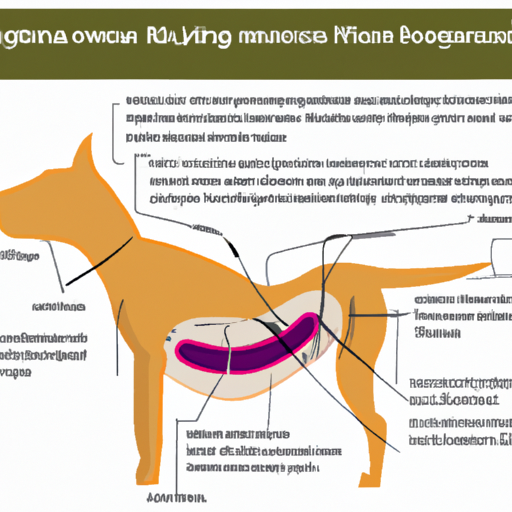Understanding the Canine Anatomy
In understanding how a dog’s stomach flips, it is essential to first comprehend the canine anatomy. You see, your dog’s stomach is somewhat like a hammock, suspended in the abdomen by a network of ligaments. This positioning allows for a certain degree of mobility.
The Phenomenon of Stomach Flipping
Stomach flipping, scientifically known as Gastric Dilatation-Volvulus (GDV), is a serious and life-threatening condition. When a dog’s stomach flips, it essentially means the stomach has twisted around itself. This twist obstructs the entry and exit points, thereby preventing blood flow to the heart and causing a rapid decline in the dog’s health.
Recognizing the Signs
If your beloved pet’s stomach has flipped, the symptoms will be very distinct and alarming:
- Excessive drooling
- Restlessness and pacing
- Swollen belly
- Attempts to vomit without success
- Weakness and eventual collapse
Prevention and Treatment
While GDV can occur in any breed, large, deep-chested dogs such as Great Danes, Saint Bernards, and Weimaraners are more susceptible. It’s crucial to adopt preventive measures:
- Feed smaller meals more frequently
- Avoid vigorous exercise after meals
- Seek early veterinary intervention if GDV signs are noticed
Once GDV occurs, it is a medical emergency requiring immediate veterinary care. Treatment typically involves:
- Stabilization with intravenous fluids and pain management
- Surgery to untwist the stomach and assess damage
- Gastropexy: a procedure to prevent recurrence
| Step | Treatment |
|---|---|
| 1 | Stabilization |
| 2 | Surgery |
| 3 | Gastropexy |
The Aftermath
Post-surgery, your pet will need careful monitoring. You’ll need to watch for complications like infection or heart rhythm abnormalities. Recovery can be a long process, but with your loving care, your pet can return to a normal, healthy life.
FAQ
Q: What causes a dog’s stomach to flip?
A: It can be due to several factors including eating large meals, vigorous exercise after eating, or a genetic predisposition in certain breeds.
Q: Is a stomach flip fatal for dogs?
A: It can be if not treated promptly. It’s a medical emergency that requires immediate veterinary care.
Q: Can all dogs experience stomach flipping?
A: While any dog can experience it, large, deep-chested breeds are more susceptible.
Q: How can I prevent my dog’s stomach from flipping?
A: Feed smaller, more frequent meals, avoid vigorous exercise after meals, and seek early veterinary intervention if GDV signs are noticed.
Q: What is the recovery process like for dogs after treatment for stomach flipping?
A: It can be a long process requiring careful monitoring for complications. With proper care, your pet can return to a normal, healthy life.
So, now that you know how a dog’s stomach flips, you can be a more vigilant caregiver for your canine companion. Remember, early detection and prompt action can save your pet’s life.



